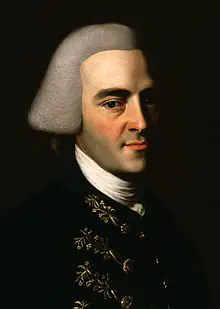John Hancock
The name of John Hancock is associated with anyone’s signature. The reason for that is due to how John Hancock signed the Declaration of Independence.
He signed the document in large cursive letters so that no one would miss his name. Hancock was a brilliant politician and held an important role in creating a state of independence for the colonies

Where did they live?
During the time of the British rule of the colonies, John Hancock was considered to be one of the wealthiest me in all of the thirteen colonies.
He inherited a successful mercantile business from his uncle, and this gave him the name to expand out and begin a political career.
He started by being Samuel Adams’ protégé, although the two men later lost interest in working together.
Facts about John Hancock
-
<
- Hancock’s wealth opened a lot of doors for him, and he invested in many of the causes to help the colonists achieve freedom. The British had Hancock on their radar and seized one of his ships by accusing him of smuggling. The charges were dropped, but this made him more popular with the people.
- As the American Revolution broke out in 1775, John Hancock was turned to as a leader in Boston. He was selected and served two years in the Continental Congress, and when he returned to Massachusetts, he was elected governor of the Commonwealth. He made sure that Massachusetts had a treaty as part of the U.S. Constitution.
- Although George Washington was selected for the job of leading the Continental Army, John Hancock had asked to be the leader.
- Hancock held a lot of positions during the colonial era, including president of the Second Continental Congress and the first and third governor of the Commonwealth of Massachusetts.
- It was while he was president of Congress that they all decided to adopt and sign the Declaration of Independence. The way the story goes, Hancock signed his name in such a large way so that King George could read it without his glasses. It is unsure if this is true, but the signature was indeed large and flamboyant.
- Unlike what some believe and what certain paintings show, there wasn’t a single time and ceremony for the signing of the Declaration of Independence on July 4, 1776. Once a document was decided upon, the “fair copy” was sent to be printed. Hancock may have signed that document that was sent to the printer, but that copy was lost. The printer had to produce the first published version, and those copies were then distributed. At the time, Hancock’s signature would have been printed instead of being signed. The signature appeared on a later document sometime after July 19 and signed on August 2 by Hancock and the delegates that were there at the time. It was a long process as people lived in other areas and had to set time aside to arrive and sign. The signed version is known as the engrossed copy and is on display in Washington, D.C., in the national archives.
- Hancock continued to participate in politics. Although he resigned in 1785 as governor, he was elected as the Continental Congress delegate that was now known as the Confederation Congress. The name change happened in 1781 after the ratification of the Articles of Confederation.
- After the war, the importance of Congress seemed to become less and less. Hancock was elected as president but couldn’t show up due to his bad health. It was also known that he had little interest, and this was confirmed when, in 1786, he sent a letter of resignation to Congress.
- Hancock’s health continued to worsen, and his last years as governor left him as little more than in name only He died in 1793 at age 56 years.
What did you learn?
What is associated with the name John Hancock?
A signature
What was Hancock’s financial position during the time of the British rule of the colonies?
The wealthiest man in all 13 colonies
What position did John Hancock have in the Second Continental Congress?
President
What positon did Hancock have in the Commonwealth of Massachusetts?
1st and 3rd governor
What is the story or myth around why John Hancock signed his name so large on the Declaration of Independence?
So that King George could read it without his glasses
What successful business did John Hancock inherit that made him so wealthy?
Mercantile



